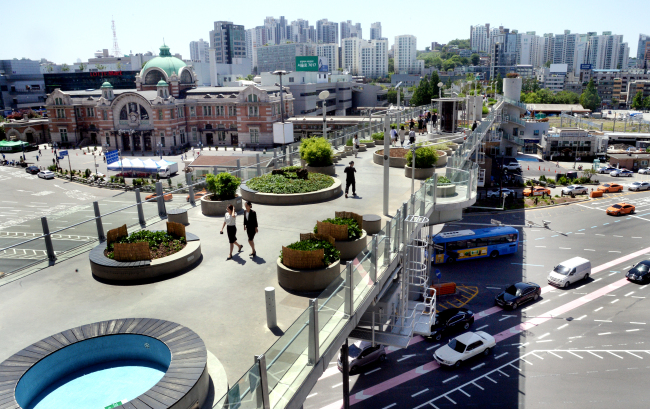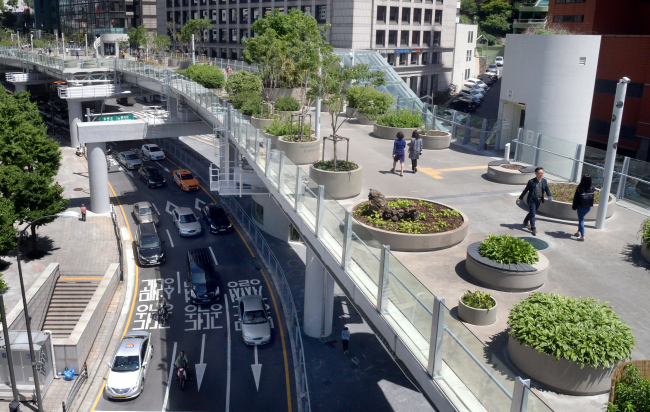Can soulless Seoul landscape inspire world’s hearts and minds?
“Most experts are in agreement that Seoullo is a failure of urban regeneration. I haven’t seen any architect or designer who said good things about it.”
By Joel LeePublished : Nov. 1, 2018 - 17:53

Walking on the Seoullo 7017 Skypark on a chilly autumn day, I didn’t feel a trace of delight or pleasure, but sheer tedium.
A cracked concrete floor stretched for a kilometer, flanked by large pots of flowers, trees and shrubs. Maudlin poetry excerpts and purple prose bedecked the pots, with tourists trying to make sense of what the metropolitan government has advertised as Seoul’s equivalent of New York City’s High Line.
When it comes to architecture and landscape, Korea consistently punches below its weight. Instead of being the “Soul of Asia,” Seoul has been dubbed a “soulless city” by critics.
Indeed, from the bizarre, monstrous Seoul City Hall to the imperious-looking Korea National Assembly Proceeding Hall, Seoul is full of architecture that is neither pretty nor inspiring. Oftentimes, they are outright inefficient, expensive to maintain and environmentally unfriendly.
Over a year and half have passed since the Seoul Skygarden opened in May last year. Seoul Mayor Park Won-soon’s administration promoted the venue as “a successful example of urban regeneration,” as it was reborn from a condemned overpass. Marking its first anniversary in June, the city government boasted of its “success” and claimed that over 10 million people had visited Seoullo.
But the chorus of self-praise has been more than offset by harsh criticism from architectural and landscape design experts, as well as academics, policymakers and politicians. Ahn Cheol-soo, the former Seoul mayoral candidate for the Bareunmirae Party, called Seoullo the “Hanging Gardens of Babylon” because of what he said was wasteful spending on the project, while former Gyeonggi Province Gov. Kim Moon-soo vowed during his mayoral bid this year to “demolish the completely useless eyesore Seoullo.”

The edifice is a case of urban regeneration failure, according to Lee Young-han, a professor at the Seoul National University of Science and Technology’s School of Architecture.
“Most experts are in agreement that Seoullo is a failure of urban regeneration. I haven’t seen any architect or designer who said good things about it,” Lee told The Korea Herald. “From the start, it should have been either a regenerated park with careful attention to details, in regards to the use of materials and landscaping, or simply a walkway without all the bombastic accoutrements attached to it now.”
Seoullo from its inception was unsuited to be a park, he argued, because the surrounding area is where the city’s key arterial roads crisscross, causing air pollution and noise. A park should have a noise level of at or below 40 decibels, equivalent to the general volume at libraries, Lee explained.
Plus, because of the concrete, the temperature soars well above 40 degrees Celsius in the summer. “The concrete simply gives off a cold, hard, barren and desolate feeling. A better-designed one would have had wooden flooring with trees flanking the walkway, and perhaps water sprinklers for summer. The people in charge of this project lacked that kind of aesthetic sensibility,” Lee said.
Seoullo was designed by Dutch firm MVRDV, which originally conceived of the skyline as an elevated arboretum. But instead, the place became a huge runway covered in pot plants, featuring over 24,085 plants representing 228 species of trees, shrubs and flowers. Much effort and money have been poured into sustaining the floral life and maintaining the facility, costing the city over $4 million each year. Seoullo’s construction cost $53 million, according to reports.
“A serious discussion and deliberation was omitted on whether a dilapidated overpass should have been preserved in the first place,” said Bae Jeong-han, a professor of architectural landscape at Seoul National University. “Seoullo has become a good case study of how a rough-and-ready space was created out of a toxic mix of populist-nostalgic appetite, ‘green-is-all-good’ sentimentalism, pork-barrel politics and absence of democratic debate and decision-making.”

Lee attributed Seoullo’s apparent ills to the larger problem of the Mayor Park administration, saying many of his policies paid lip service to structural urban quandaries without tackling them deep down based on rational, fundamental analysis.
“For Seoul and other Korean cities to become world-class, a fundamental change in architecture, design and business has to happen,” Lee stressed, adding that the country’s buildings have been created to maximize space at the lowest cost and to be built in the shortest time frame. “As a result, there is no attention to detail in Korean architecture. This is different in Japan, where experts have done things both professionally and artistically. A culture of respecting artists and designers’ creativity is much needed, but in short supply in Korea.”
Successful examples of urban regeneration include the Cheonggye Stream and Dongdaemun Design Plaza, despite manifold criticisms directed at them, he added.
“Generally speaking, it will be increasingly difficult to elevate the quality of architecture in Korea -- a country with a waning population and economy -- because ultimately it’s about facility investment, which costs a lot of money,” Lee said. “On the positive light, our national landscape holds much potential for creative regeneration. Areas near mountains, streams and rivers can be repurposed into highly beautiful, aesthetic places.”
Architecture, landscape design and urban, environmental and transportation planning can be integrated with tourism, he pointed out, adding that clean air and creative storytelling techniques can be added to the equation.
By Joel Lee (joel@heraldcorp.com)







![[Graphic News] More Koreans say they plan long-distance trips this year](http://res.heraldm.com/phpwas/restmb_idxmake.php?idx=644&simg=/content/image/2024/04/17/20240417050828_0.gif&u=)
![[KH Explains] Hyundai's full hybrid edge to pay off amid slow transition to pure EVs](http://res.heraldm.com/phpwas/restmb_idxmake.php?idx=644&simg=/content/image/2024/04/18/20240418050645_0.jpg&u=20240419100350)





![[From the Scene] Monks, Buddhists hail return of remains of Buddhas](http://res.heraldm.com/phpwas/restmb_idxmake.php?idx=652&simg=/content/image/2024/04/19/20240419050617_0.jpg&u=20240419175937)

![[KH Explains] Hyundai's full hybrid edge to pay off amid slow transition to pure EVs](http://res.heraldm.com/phpwas/restmb_idxmake.php?idx=652&simg=/content/image/2024/04/18/20240418050645_0.jpg&u=20240419100350)

![[Today’s K-pop] Illit drops debut single remix](http://res.heraldm.com/phpwas/restmb_idxmake.php?idx=642&simg=/content/image/2024/04/19/20240419050612_0.jpg&u=)